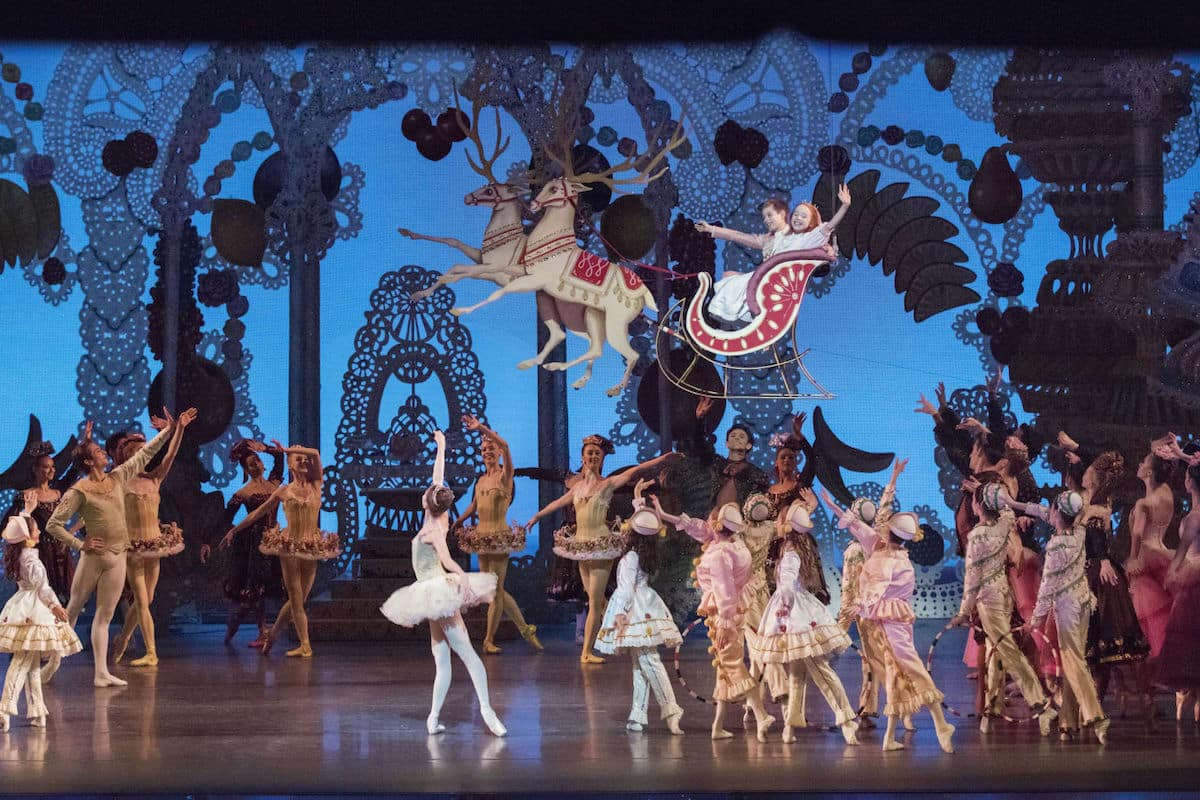Tchaikovsky’s Nutcracker is performed all over the world during the festive season, but there is one version that surpasses all others: George Balanchine’s The Nutcracker by New York City Ballet. Presented at Lincoln Center, this legendary show is the most prestigious and famous production of this Christmas ballet. If you’re a fan of classical dance or if you’re looking for an exceptional cultural experience during your stay in New York, this is the show for you.
Presentation of the show
George Balanchine’s The Nutcracker is much more than a simple Christmas ballet: it is a New York cultural institution and the world reference for this fairytale. Presented each year at Lincoln Center‘s David H. Koch Theater, this dazzling show features more than 90 dancers from the New York City Ballet, 62 live musicians, 40 stagehands and more than 125 children from the prestigious School of American Ballet.
The story of The Nutcracker
The ballet tells the story of Marie (Clara in some versions), a young girl who receives a soldier-shaped nutcracker for Christmas. As night falls, she witnesses a spectacular battle between the Nutcracker and the Mouse King. After the Nutcracker is victorious and transformed into a prince, Marie is taken on a magical journey through the Snow Kingdom and the Land of Sweets, where she witnesses sumptuous dances from the four corners of the world.
Unforgettable moments
This Balanchine production features several scenes that have become legendary:
The giant Christmas tree: the most spectacular moment of the show! A Christmas tree that magically grows before your very eyes, from its normal size to a height of 12 metres (40 feet) thanks to an ingenious mechanism and breathtaking visual effects.
The snow scene: a magical tableau in which dozens of dancers whirl around in a sparkling snowstorm, creating an unforgettable magical atmosphere. It is one of the most poetic moments in the ballet.
The Waltz of the Flowers: a sophisticated, elegant choreography in which the dancers move gracefully in sumptuous costumes.
The characteristic dances: variations from different countries (Spain, Arabia, China, Russia) offering a variety of choreographic styles.
The sugar pas de deux: the ballet’s great romantic moment, danced by the company’s first dancers, demonstrating the virtuosity and elegance of classical dance at the highest level.
Tchaikovsky’s music
The score by Pyotr Ilyich Tchaikovsky (1840-1893) is one of the most famous and beloved in the entire classical repertoire. Performed live by a 62-strong orchestra, it includes unforgettable melodies such as the Dance of the Sugar Plum Fairy, the Waltz of the Flowers and the March. The experience of hearing this music played live by the New York City Ballet orchestra adds an extra dimension to the magic of the show.
The story of this legendary production
George Balanchine: the master of ballet
George Balanchine (1904-1983) is considered to be the most influential choreographer of the 20th century and the father of American ballet. Born in Russia as Giorgi Balanchivadze, he trained at the Imperial Ballet School in St Petersburg before leaving the Soviet Union in the 1920s.
In 1933, Balanchine arrived in the United States at the invitation of Lincoln Kirstein, a patron of the arts and dance enthusiast. Together they founded the School of American Ballet in 1934, then the Ballet Society in 1946, which became the New York City Ballet in 1948. Balanchine was its artistic director until his death in 1983, creating over 400 choreographic works that revolutionised the art of ballet.
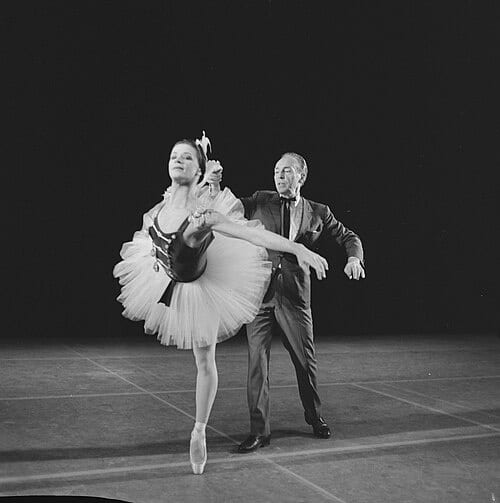
The creation in 1954
George Balanchine’s The Nutcracker premiered on February 2, 1954 at the City Center of Music and Drama in New York. It was the first large-scale American production of The Nutcracker, a ballet with which Balanchine was very familiar, having danced in the original production at the Mariinsky Theatre in St Petersburg when he was a child.
This creation was revolutionary for several reasons:
The involvement of children: Balanchine made the bold choice to entrust important roles to children, notably that of Marie. More than 40 children take part in each performance, bringing a special authenticity and magic to the show.
An American narrative ballet: whereas European ballet often favoured pure virtuosity, Balanchine has created a version that perfectly balances narrative, fairytale and high-level dance.
Innovative choreography: Balanchine reinvented ballet choreography, creating new steps and sequences that have become the world standard. His version is now the most imitated in the world.
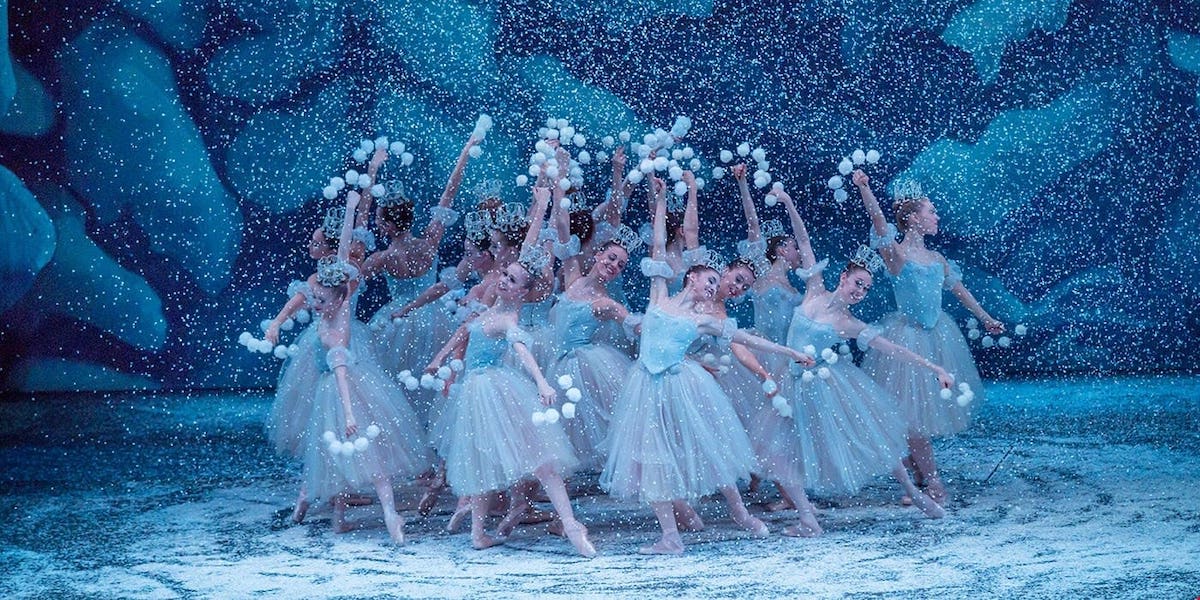
Immediate and lasting success
From its very first season, the show was a resounding success. It quickly became an annual tradition for the New York City Ballet and New York City. Since 1954, the show has been performed every year without interruption, generating millions of dollars in revenue and attracting audiences from all over the world.
In 1964, the ballet moved to the brand new New York State Theater (now the David H. Koch Theater) at Lincoln Center, its current home. The theater was partly designed by Balanchine himself to meet the specific needs of the New York City Ballet.
A cultural heritage
The Nutcracker has become much more than just a ballet, it is an American cultural phenomenon. The show has :
- Inspired hundreds of productions across the United States and around the world
- Launched the tradition of Christmas ballet in countless American cities
- Trained generations of dancers at the School of American Ballet
- Generated millions of dollars that fund other New York City Ballet productions throughout the year
The original sets were created by Rouben Ter-Arutunian and the sumptuous costumes by legendary Academy Award-winning costume designer Barbara Karinska. These spectacular visual elements are an integral part of the show’s success.
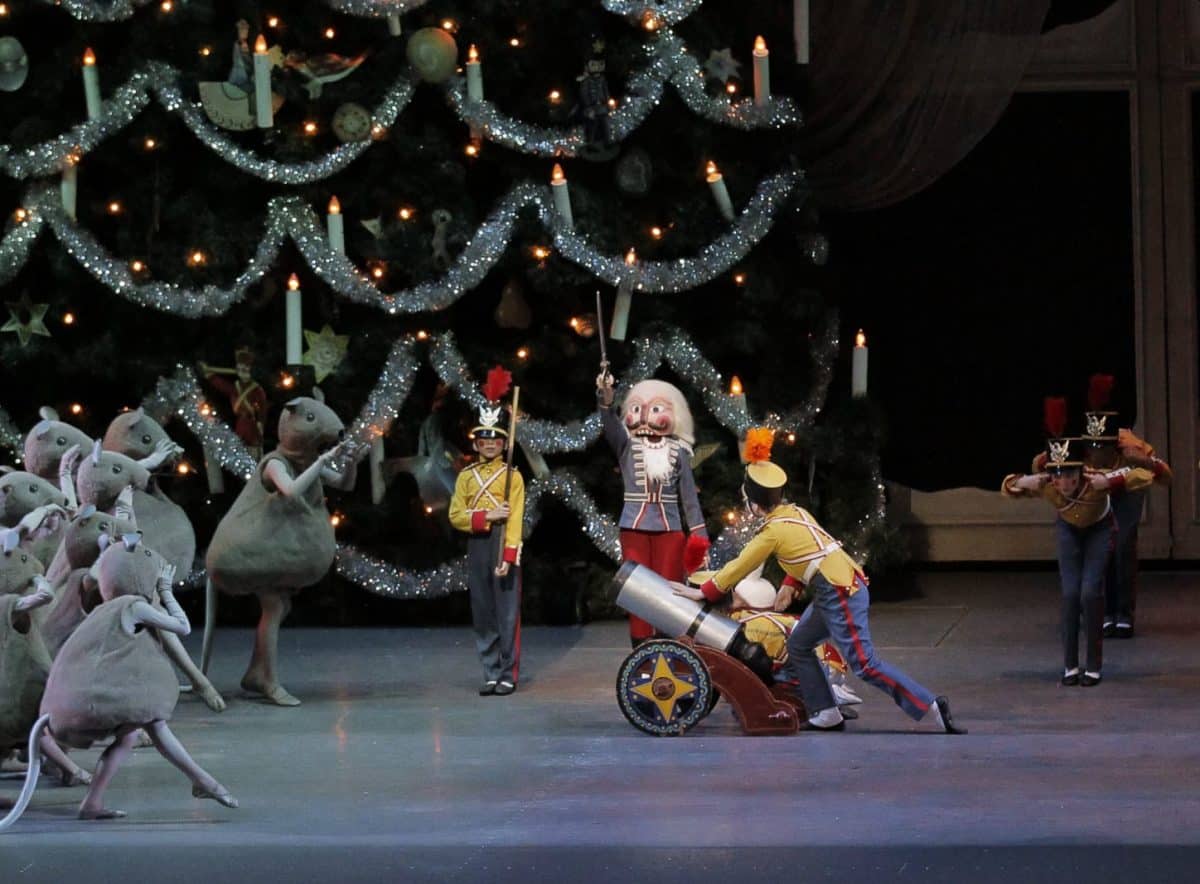
The tradition continues
More than 70 years after its creation, George Balanchine’s The Nutcracker continues to enchant audiences with the same magic. Balanchine’s choreography is protected and preserved by the George Balanchine Trust, ensuring that his artistic vision remains intact. Every year, new dancers and children discover the joy of dancing in this legendary production, perpetuating a legacy that spans generations.
How much does a ticket to the show cost?
Ticket prices for George Balanchine’s The Nutcracker vary considerably depending on a number of factors, but are generally more affordable than other New York Christmas shows of the same calibre.
Variable prices
Prices depend on :
- Date and time: performances are more expensive at weekends and during school holidays
- Location in the auditorium: from the orchestra to the fifth ring (upper balcony)
- Type of seat: standard or premium ‘Sweet Seats
Price ranges
Standard price (2025 season) :
- Tickets start at around $30 to $50 for the furthest seats (Fourth and Fifth rings)
- Third Ring and Fourth Ring seats generally cost between $50 and $90
- Second Ring seats are between $90 and $150
- Seats in the First Ring (main balcony): $150 to $250
- TheOrchestra: between $180 and $400 depending on your position
Where and when can I buy tickets?
George Balanchine’s The Nutcracker attracts tens of thousands of spectators from all over the world every year. It is one of the most popular ballets in the United States, and the best seats sell out very quickly, especially over the weekends in December and Christmas week.
Please note: this is a seasonal show that runs only during the festive season, from 28 November 2025 to 3 January 2026. If you are planning a trip to New York over the Christmas period and would like to see this legendary ballet, don’t delay in booking your tickets for an extraordinary cultural and artistic experience!
Which seats to choose?
The David H. Koch Theater at Lincoln Center has around 2,700 seats spread over five levels. The theatre’s modern architecture, designed in part to Balanchine’s own specifications, offers excellent visibility from virtually every seat.
Architecture of the theatre
Levels :
- Orchestra: main level on the ground floor
- First Ring: first balcony
- Second Ring: second balcony
- Third Ring: third balcony
- Fourth Ring: fourth balcony
The theatre has a horseshoe configuration with excellent acoustics and clear sightlines from most seats.
The best seats
Orchestra in the centre (rows D to M):
Price: $$$$ (most expensive, $250-$400)

First Ring in the centre (rows A to D) :
Price: $$$ (200-300$)
Second Ring in the centre (rows A to C):
Price: $$ (90-150$)
Orchestra on the sides (side sections) :
Price: $$ (150-250$)
Places to avoid
First rows of the Orchestra
(A to C)
Difficult to see the tree properly
Extreme side seats :
Part of the action may be hidden
Fifth Ring :
Generally only booked if everything else is full
My opinion on The Nutcracker
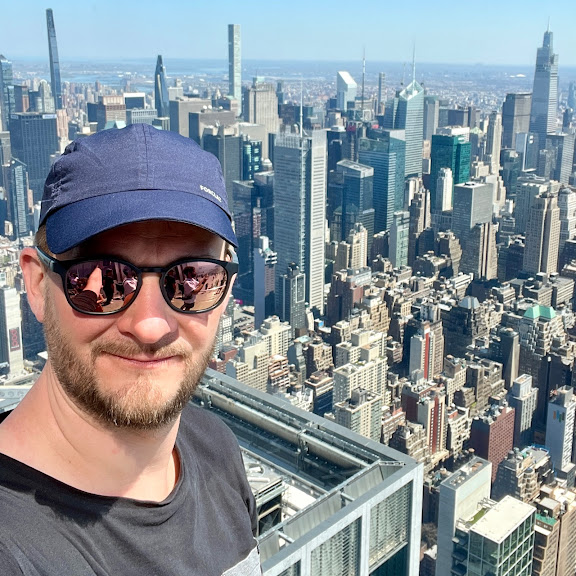
George Balanchine’s The Nutcracker is a living masterpiece and one of the finest cultural experiences you can have in New York this holiday season. It’s art of the highest quality, presented by the world’s finest artists, in a beautiful setting.
Yes, it’s classical ballet, and therefore not for everyone. But if you have even the slightest appreciation of dance, classical music or fairy tales, you will be transported. The sheer beauty of this show is overwhelming.
My recommendation: if you love high-brow culture and ballet, or if you want to introduce your children to the world of classical dance, this is an absolute must-see. Invest in good seats(Second Ring centre minimum), let yourself be carried away by the magic, and prepare to experience a moment of pure emotion and beauty.
Practical information
Dates and times
2025-2026 season: from November 28, 2025 to January 3, 2026
Performance times :
- Mornings: generally at 1:00 or 2:00 p.m
- Evenings: generally at 19:00 or 20:00
- Some dates offer two performances (matinee and evening)
- Weekends often have several performances
Check the full calendar when you book to see all the available times.
The show starts at the precise time indicated. Out of respect for the artists and the audience, no late entrances are permitted once the show has started. Latecomers will not be allowed into the auditorium.
Venue and access
David H. Koch Theater Lincoln Center for the Performing Arts 20 Lincoln Center Plaza New York, NY 10023
Subway (highly recommended) :
72nd Street station: lines 1, 2, 3 (8-minute walk)
Bus: lines M5, M7, M10, M66, M104 all stop near Lincoln Center
By car: There are several car parks nearby, but they are very expensive ($50-70 on average) and often full. The metro is highly recommended.
Total running time and format
Total running time: approximately 2 hours
Structure: two acts with a 20-minute intermission
Language: the ballet is entirely in music and dance, with no spoken dialogue. No language barrier!
Accessibility and catering
The David H. Koch Theater is fully accessible to people with reduced mobility. A bar offering drinks and snacks is available in the theater before the show and during the interval (high prices, no outside food allowed). Lincoln Center is home to several restaurants, including Lincoln Ristorante (upscale Italian), The Revere (casual) and various cafés throughout the complex.
Arrival and recommended age
Arrive at least 30 to 45 minutes before the start time for :
- Avoid the stress of possible delays
- Collect your tickets if necessary
- Enjoy the festive atmosphere of Lincoln Center
- Admire the illuminated plaza and fountain
- Leave your coats in the cloakroom
- Buy a drink for the interval
- Settle comfortably into your seats
Ballet is suitable for all ages, but :
- Recommended from 5-6 years for children who can enjoy a 2-hour show
- All spectators (including babies) must have a ticket
- Children must be able to remain seated and silent during the performance
- The interval allows young children to take a break
This is often children’s first ballet, and the enchanting story of The Nutcracker is the perfect way to introduce young audiences to the world of classical ballet.
Frequently asked questions
George Balanchine’s The Nutcracker is a seasonal performance presented only during the holiday season. For the 2025-2026 season, the ballet runs from November 28, 2025 to January 3, 2026 at Lincoln Center‘s David H. Koch Theater. Several performances are offered each day, usually matinees (1pm or 2pm) and evenings (7pm or 8pm), particularly on weekends and during school holidays.
The ballet lasts about 2 hours in total, divided into two acts with a 20-minute intermission. The first act (Christmas scene, battle with the Mouse King, snow scene) lasts about 45 minutes, followed by the interval, then the second act (Land of Sweets, characteristic dances, grand Pas de Deux) also lasts about 45 minutes. The show starts on time and no late entrances are permitted once the performance has begun.
There is no strict dress code at the David H. Koch Theater, but ballet generally inspires more elegant dress than other shows. For evening performances, smart casual to semi-formal dress is common (suit, sports jacket, elegant dress). Matinees are more casual, especially for families with children. In winter, bring a warm coat for travelling – a free cloakroom is available at the theatre.
No, photos, videos and audio recordings are strictly forbidden during the performance, out of respect for the artists and other spectators. However, you can take as many photos as you like in the public areas of the theatre before and after the show, as well as on Lincoln Center‘s beautifully illuminated plaza during the festive season – the perfect place for superb souvenir photos!
Lincoln Center is located on theUpper West Side of Manhattan, one of New York’s most pleasant neighbourhoods. In the immediate vicinity you will find :
- Central Park (5 minutes’ walk): ideal for a stroll before or after the show
- Columbus Circle (5 minutes): shopping at the Time Warner Center and magnificent views
- Lincoln Center Plaza itself: illuminated fountain, Christmas decorations, magical atmosphere
- Broadway and Columbus Avenue: numerous restaurants, cafés and boutiques
- American Museum of Natural History (10-minute walk)
- Riverside Park: walk along the Hudson River
There are also plenty of excellent restaurants in the area where you can dine before or after the show. It’s the perfect opportunity to combine culture and discovery of one of New York’s most beautiful neighbourhoods for a full day of Christmas magic!
